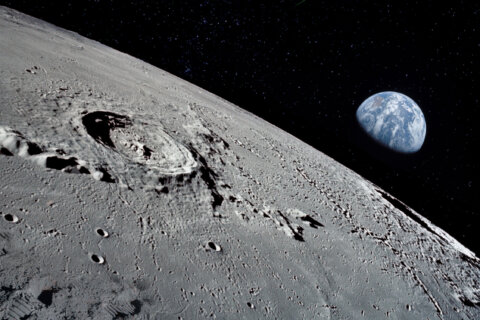Jason Fraley, WTOP film critic
WASHINGTON – “Near, far, wherever you are.”
The unmistakable song lyrics from “Titanic” no longer belong just to Celine Dion; they now also apply to the effect of 3D glasses, changing our depth perception of the “iceberg right ahead.”
The “unsinkable” 1997 blockbuster has returned to theaters in a special 3D re-release marking the 15th anniversary of the film and the 100th anniversary of the ship’s infamous sinking on April 15, 1912.
The additional box office receipts could return “Titanic” to its rightful place above “Avatar” (2009) as the top grosser for director James Cameron — and that’s just fine by me. “Avatar” may be hailed as the highest-grossing movie of all time in terms of sheer dollars ($760 million), but if you adjust for inflation, it’s No. 14. “Titanic” is No. 6 ($1 billion), behind only “Gone With the Wind,” “Star Wars,” “The Sound of Music,” “E.T.” and “The Ten Commandments.” These stats include re-releases, meaning “Titanic” could very well rise the more it takes on water.
In addition to breaking box office records, “Titanic” also tied “Ben-Hur” (1959) and “The Lord of the Rings: Return of the King” (2003) with a record 11 Oscars, including Best Picture. It was one of those rare moments — like “Rocky” (1976) and “Forrest Gump” (1994) — when the blockbuster of the year was also the most acclaimed by the Academy. Such approval from both the art and entertainment wings of Hollywood is rare.
As with anything so popular and so acclaimed, there was immediately a backlash — from mainstream fans who grew tired of going to see it with their girlfriends to academics angry that a massive blockbuster was wiping out competition like “Happy Together” (1997) and “L.A. Confidential” (1997). This anger has festered for 15 years, leaving a split reaction today between those who get teary-eyed just thinking about the movie, and those who roll their eyes at its sentimentality.
Case in point: “Titanic” did not receive a single vote on the elite Sight & Sound international critics poll, but it recently ranked 83rd in the American Film Institute’s Top 100 Films of All Time. Both lists were topped by “Citizen Kane,” yet one included “Titanic,” and one did not.
The 3D re-release won’t stop any of the crying or eye-rolling, as the limited 3D does little to change our initial impressions. After all, “Titanic” was originally shot in 2D and converted to 3D after the fact.
Still, there are some cool 3D elements, from in-your-face bubbles making us feel like we’re actually exploring the underwater wreckage, to Rose’s giant purple hat nearly whacking us in the face in Southampton. Of course, the 3D moment everyone will be waiting for is the big “I’m flying” scene on the bow, the most memorable part of a ship that looks just as glorious as it did in 1997.
We shouldn’t be surprised at all that Cameron would revisit this in 3D. He’s the effects-driven director of action flicks like “The Terminator” (1984), “Aliens” (1986), “The Abyss” (1989), “T2: Judgment Day” (1991), “True Lies” (1994) and “Avatar” (2009), where he pioneered the technology for a new generation. Naturally, I was skeptical when I heard he was pulling a George Lucas and digitally doctoring his original work. However, after seeing “Titanic 3D,” I’m fine with his decision to replace the film’s original night sky with a new, identical match of the exact astronomy of that fateful night.
The change shows two things: First, Cameron’s perfectionist attention to detail, to the point of hiring the original companies that provided the actual Titanic with its china and chandeliers to assist the art department. Second, it shows Cameron’s reverence to the actual tragic event and his childlike wonder at the mystery of the Titanic. Since the film, Cameron has dumped much of his wealth to conduct actual underwater missions to the Titanic site, telling National Geographic he was more excited about the underwater expeditions than making the movie.
On a symbolic level, the night sky plays into the film’s notion of star-crossed lovers. How fitting then that “Titanic” brought us two of today’s brightest stars in Leonardo DiCaprio and Kate Winslet. No matter how many “better” performances they give — DiCaprio as Scorsese’s new DeNiro and Winslet as an Oscar- winning powerhouse — they’ll always be Jack and Rose. Their love story is timeless; a forbidden love between the 99 percent and the 1 percent; between the drifting artist who won his way onto Titanic in a lucky hand of poker and the wealthy socialite marrying into money to preserve the family fortune. Billy Zane’s heartless fiance Cal, Frances Fisher’s corset-cinching mother and Kathy Bates’ “new money” Molly form the outside forces that shape their journey.
A good analogy would be Rhett Butler and Scarlett O’Hara in “Gone With the Wind” (1939). Both are star-crossed lovers brought together amidst historic tragedies (Civil War vs. Unsinkable Ship). Both heroines launch powerful crane shots, starting on the single heroine (Scarlett/Rose) and rising up into the sky to reveal a mass of devastation (Wounded Confederate soldiers vs. Titanic passengers in the water). And both were the big-budget Hollywood productions of their day, Cameron serving as a modern- day David O. Selznick by shooting with a budget of over $200 million and a 775-foot replica of the famous cruiseliner. How fitting that “Gone With the Wind” is the film “Titanic” is chasing at the top of the all-time adjusted box office list.
“In spite of the wonderful, massive action that exists in ‘Titanic,’ what resonates with people is the love story,” said William Friedkin, director of “The French Connection” (1971) and “The Exorcist” (1973). “Those young people, Kate Winslet and Leonardo DiCaprio, caught the imagination of this generation the way Bergman and Bogart did in ‘Casablanca’ 60 years before. You fall in love with the characters, and that’s why, in my opinion, ‘Titanic’ equals ‘Casablanca’ as an iconic love story.”
Such comparisons to “Casablanca” and “Gone With the Wind” might stun you initially, but try thinking about it with the nostalgia removed. Aren’t all three equally melodramatic? Your honor, I present Ingrid Bergman’s line, “Was that cannon fire or is it my heart pounding?” or Vivien Leigh’s fist-pumping, “I’ll never be hungry again!” Even my favorite film, “Vertigo” (1985), has the melodramatic moment of Jimmy Stewart and Kim Novak kissing against crashing waves.
Granted, “Vertigo” is filled with some of the best “mise-en-scene” in movie history; “Casablanca” is much better written; and “Gone with the Wind” was much more groundbreaking from a production standpoint. This is why these films are all in the AFI’s Top 10, while Titanic is at No. 83. We should compare the films on these grounds, not simply on melodrama, which serves more as a style or sub-genre (see the work of Douglas Sirk). Cameron will never be thought of in the light of a Hitchcock or Welles or Godard; he seems more on track to join the Spielbergs, Lucases, and DeMilles.
Cameron is not nearly as “genius” a director as he fancies himself to be, but he’s also not as bad as many of his critics insist. Note the underwater shot from the nude drawing’s perspective. Note the parallel action cutting back and forth from the wild, below-deck party to the quiet, cigar session upstairs. And note the suspense as the ship steers hard left to avoid the iceberg, even though we know it’s going to hit. The pacing puts Michael Bay’s “Pearl Harbor” to shame, building up to the disaster, rather than starting anti-climatically with it.
Don’t get me wrong. The film certainly has its flaws. Elements of the story are clearly far-fetched, like the suggestion that Jack and Rose’s sex is the reason for the distracted night watchmen, or the young couple’s ability to be the very last people in the water, riding the ship’s stern down together. The story is also unoriginal, with a number of previous movie versions, including “Titanic” (1953), starring Clifton Webb, Barbara Stanwyck, Robert Wagner and Thelma Ritter, and “A Night to Remember” (1958), a British gem that’s part of the Criterion Collection.
Still, none of these became the global smash hit that the 1997 version turned out to be. The Taliban even had to ban Leo-style haircuts because it worried Afghan children were seeing bootlegs and becoming too Westernized. The film has become a true pop phenomenon that overshadows even its own merits. Some of us mock the melodramatic music (James Horner and Celine Dion) and the cheesy dialogue (“I’ll never let go, Jack”), yet there’s a reason we know them all by heart.
For their pop culture impact, the AFI named Celine Dion’s “My Heart Will Go On” the 14th Greatest Movie Song of All Time, just ahead of “Cheek to Cheek” from “Top Hat” (1935), and ranked DiCaprio’s “I’m the king of the world” at No. 100 on the AFI Top 100 Movies Quotes, one spot behind, “I’ll get you, my pretty, and your little dog, too.”
From Fred Astaire to Judy Garland, “Titanic” hangs with the best of them when it comes to pop culture impact. If it was cliche for audiences to love “Titanic” upon its release, it has become just as cliche for critics to ignore its place in movie history. The pendulum is swinging — starting with mass affection, swinging quickly to backlash, and now hopefully back toward newfound appreciation.
There’s a scene at the end of the film where Bill Paxton says, “Three years, I’ve thought of nothing except Titanic; but I never got it. I never let it in.” Critics of “Titanic” could say the same: “For 15 years, we’ve thought of nothing except ‘Titanic,’ but we never got it. We never let it in.”
“Titanic 3D” should be a time not merely to revel in three dimensions, but to reflect back upon a true pop culture phenomenon. This is the time to let it in.
★ ★ ★ ★
The above rating is based on a 4-star system. Read more from WTOP Film Critic Jason Fraley by clicking “Fraley on Film” under the “Living” tab above, and check out his blog, The Film Spectrum.
(Copyright 2012 by WTOP. All Rights Reserved.)








